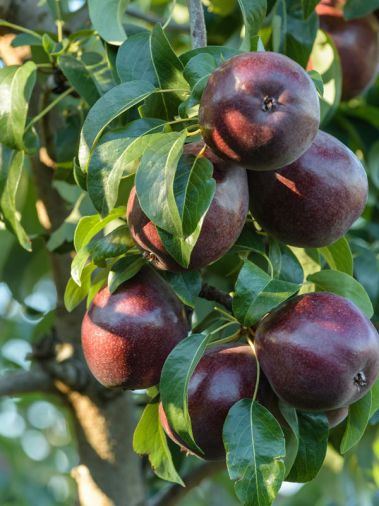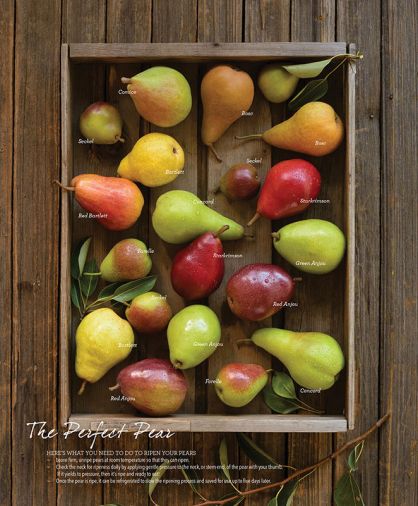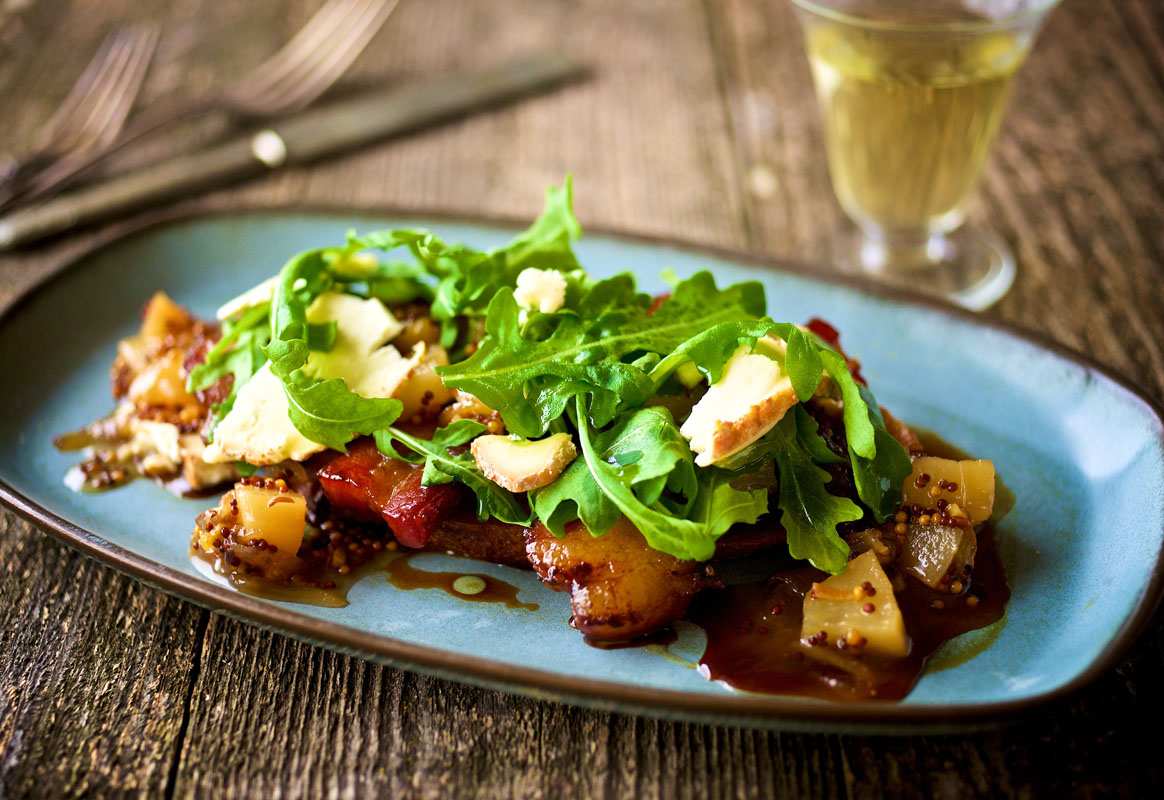Gordy Sato’s family has been growing pears in the Hood River valley for more than 100 years. But Gordy never thought he’d become an orchardist—and, for a while, he wasn’t. After business school at OSU, he launched a career as a buyer in the fashion industry, working for companies like Nordstrom and Meier & Frank and covering territory all over the West Coast. “When you’re young, you want to be where the action is, and it most definitely was not in Hood River on a farm,” laughs Gordy.
But after 26 years of long workdays and tons of travel, that all changed. Gordy was coming back from his monthly sales trip to Hawaii, and on the plane, he realized his life needed a change. “The next morning, I got up, called my boss, and quit,” says Gordy. “And the second call was to my father, saying ‘I’m coming back to the farm.’”
That was 22 years ago. Today, Gordy is one of the leading pear growers in Hood River, with a 160-acre orchard planted in seven different varieties. Has he ever regretted trading fashion for farming? “I think I’m in God’s country,” he says. “I live in my grandma’s house and I look right at Mt. Hood. To be a pear grower is a great thing.”
There’s something special about pears. If apples are an everyday, toss-one-in-the-lunchbox kind of fruit, a pear says “party”—sophisticated, delicate, seductive, with a graceful silhouette and musky, perfumed flavor. Except there’s no reason pears need to be saved for special occasions, especially not here in the Northwest, where the vast majority of the nation’s pears are grown.
Oregon and Washington produce 84% of the nation's fresh pear crop. Oregon produces more pears by weight than any other fruit. This year, we’ll ship about 792 million pounds of pears to buyers around the world, where they’ll appear on shelves from your local grocer all the way to China. This region has also been growing pears for a very long time. Early settlers tucked pear whips (little single-branch seedlings) into the backs of their covered wagons before setting out on the Oregon Trail. Once they arrived in the Northwest, they discovered with pleasure that the mild climate was just right for orchard fruits, and soon orchards in the Willamette Valley and throughout the Columbia Gorge were supplying fruit that filled freight trains destined for hungry markets back home.
Pears are particularly well suited to travel, and unlike many other crops, we don’t have to sacrifice flavor for shippability. That’s because pears are best when they’re harvested when still quite firm and allowed to ripen off the tree. Leave them on the tree too long, and they’re more likely to pick up that odd grittiness, and they can be more prone to rot rather than sweeten.
It’s counterintuitive, especially for those of us who have been trained to believe that tree-ripened anything is the only way to go. Yet pears have been bred for centuries to fill that critical gap between harvest and springtime, when most people had to settle for dried fruit—or no fruit at all. In France, one variety, Passe Crassane, is known as a winter pear. It’s traditionally harvested in mid-December and stored for at least one month—if not several—before eating to develop its best flavor. Here in the Northwest, we, too, have a favorite winter pear, the D’Anjou, which is at its finest from January to April, an otherwise grim time for locally grown fruit.
Despite pears’ incredible keeping powers and delicious flavor, they have one major problem: us. Most of us just don’t know how to pick a good pear, and we’ve all suffered through mealy, crunchy, or brown-in-the-middle fruit at least once or twice. But it doesn’t have to be this way. Here’s what you need to know to make sure you never eat an under- or over-ripe pear again.
First, don’t worry about buying pears already ripe at the grocery store. Pears ripen successfully off the tree, so you want to pick fruit that’s firm to the touch. Then, take it home and put it on your counter. If you’re in a hurry, put it in a paper bag with an apple or banana, both reliable producers of the ethylene gas that accelerates fruit ripening. The next day, gently press the neck of the pear near the stem. If it’s still hard, you’ve got longer to wait. But the minute it starts to feel soft, you’re in business.
Pears ripen from the inside out, which means by the time the rounded belly of the pear is soft, the inside will likely be overripe, or even rotten. So don’t delay. If you’re not planning to eat your ripe pears right away, they’ll hold for a couple of days in the refrigerator.
And that, of course, is the fun part—eating. A good pear is one of the purest pleasures in life, equally at home in a savory salad, a sweet crisp, or just alongside a few thin shavings of Parmesan cheese and a handful of roasted walnuts. Or, of course, out of hand, although be cautious; the only fruit that competes in terms of catastrophic, outfit-ruining juiciness is a peach, and even those can’t hold a candle to a perfectly ripe Comice.
At Zupan’s Markets, cheesemonger Kristen Kidney says pears are one of her favorite additions to a cheese board, especially one featuring cheeses from Oregon and Washington. “I think the Northwest is absolutely making world-class cheese,” says Kristen, “and our customers think so, too.” Rogue River Blue from Central Point, Oregon, is one of her favorite cheeses for accompanying pears. “Not only are blue cheese and pears wonderful together, this cheese is wrapped in grape leaves soaked in pear liqueur, so it’s already part of the flavor profile.”
When designing a pear-cheese pairing, Kristen thinks about matching the weight and intensity of the individual components’ flavors so one doesn’t overpower the other. Asian pears go well with lighter goat cheeses, for instance, while heartier Boscs can stand up to a nutty Parmesan. But don’t stress too much about getting it “right.” “Honestly, it’s kind of fool proof,” laughs Kristen. “Some pairings are better than others, but no matter what, I don’t think you’re going to have a bad time.”
Jason French, the chef and owner of Ned Ludd and Elder Hall in Portland, Oregon loves using pears in both sweet and savory dishes inspired by French and British cooking traditions. “One of the best aspects of the pear is that it’s not too sweet, which makes it very interesting,” says Jason. He often showcases the aromatic qualities of pears by poaching them in simple syrup, or sautéing them with butter and a pinch of sugar before finishing them with a squeeze of lemon juice. Jason also suggests exploring pears’ spicy side by combining them with robust seasonings and aromatics, like Piment d’Espelette, black pepper, or anise.
Or, follow Gordy’s lead, and introduce your pears to the bar. “I make the best pear ginger vodka martini,” laughs Gordy. “It’s my personal signature.”
* * *
CHEESE & WINE PAIRINGS
Wine Recommendations by Eric Degerman, www.greatnwwines.com
Cheese Pairings by Kristen Kidney, Cheesemonger, Zupan's Markets
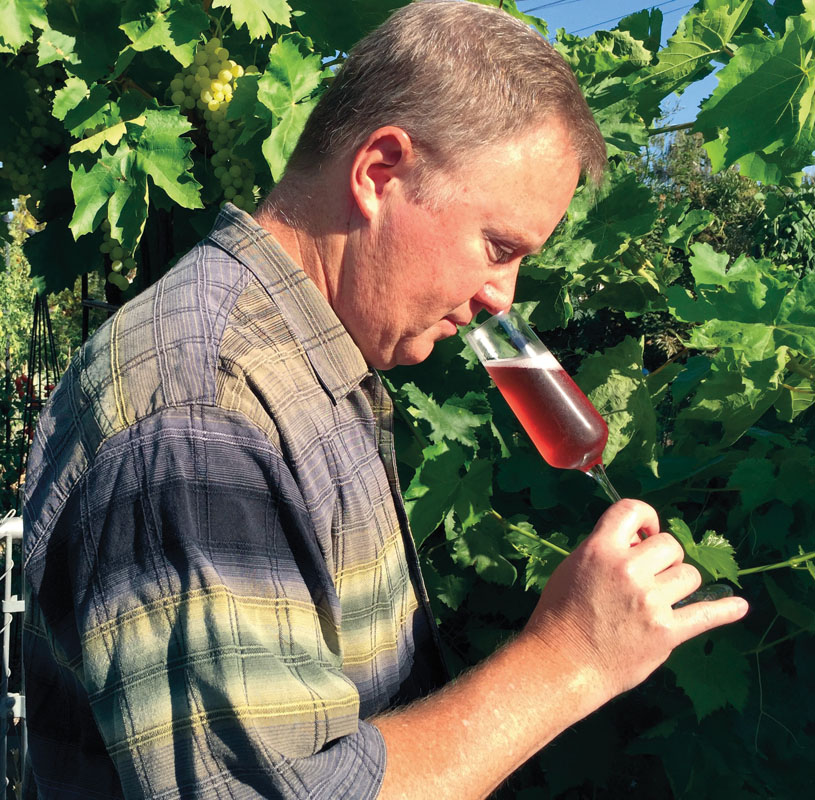

Eric Degerman is a noted columnist on Northwest wine, as well as president and CEO of Great Northwest Wine. In addition to his wine stories and tasting notes for Portrait Magazine, Eric’s talents also include judging for the San Francisco Chronicle Wine Competition, Washington State Wine Competition, Savor Northwest, Oregon’s Greatest of the Grape and the Idaho Wine Competition.
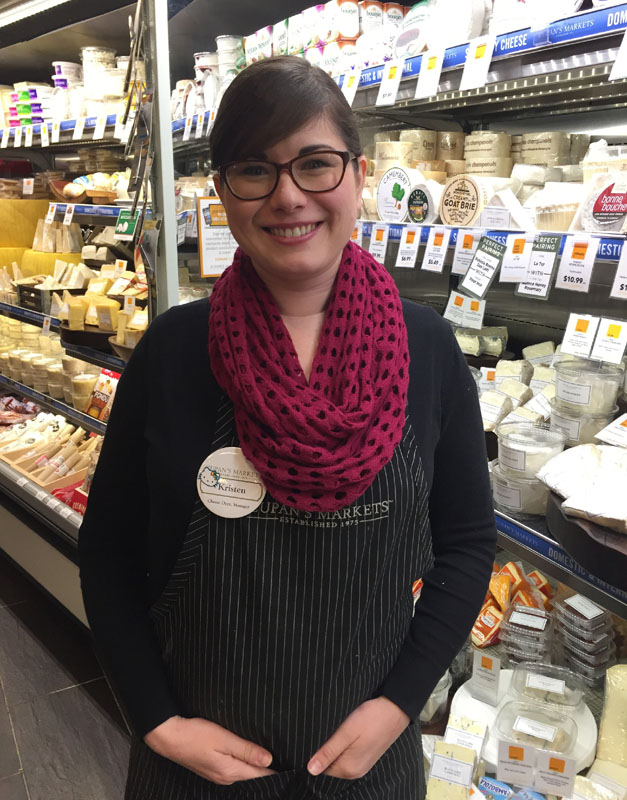
Kristen Kidney, Cheesemonger for Zupan's Markets on SW Burnside is a very familiar face for long-time customers. With carts full of locally sourced meats, produce and wines, customers’ last stops are often to the cheese department for Kristen to pair it all for with the perfect Northwest cheeses for entertaining.
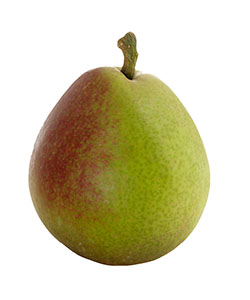
Seckel
Seckel Pears are tiny pears, with a chubby, round body, small neck, and short stem. The smallest of all commercially grown pears, Seckels are exceptionally sweet. So sweet in fact, that the bite-size morsels are sometimes called "sugar pears."
Wine Pairings
Domaine Drouhin Oregon 2014 Pinot Noir, Dundee Hills, $45
A discreet involvement of new French oak barrels allows for the ripeness of 2014 to show. Fruity aromas of black raspberry and Bing cherry include cocoa powder, black olive and dusty minerality. Black cherries pop on the satiny entry as raspberry skin tannins and pomegranate juicy acidity combine for an elegant finish. DomaineDrouhin.com
Erath Winery 2015 Pinot Gris, Oregon, $14
This legendary property in the heart of Oregon's Dundee Hills remains famous for Pinot Noir thanks to veteran winemaker Gary Horner, but his bargain-priced Pinot Gris should not be overlooked. Undertones of apple blossom, minerality and honey are backed by honeydew melon and slices of white peach and apricot. Erath.com
Torii Mor 2015 Pinot Blanc, Oregon, $20
Vineyards at both ends of the state come together seamlessly in the glass after much of the blend spent several weeks in neutral barrel, allowing for floral notes to join flavors of Honeycrisp apple, fresh pineapple and pear butter. An injection of Red Ruby grapefruit makes for a rewarding and lasting finish. ToriiMorWinery.com
Cheese Pairings
Willamette Valley Cheese Company, Brindisi
Located in Salem, OR, Willamette Valley Cheese Company's original Brindisi - an aged Fontina-style cheese - bears wonderful earthy, flinty, and sharp flavors followed by a mellow buttery finish from the Jersey cow's milk. The contrast of the honeyed profile of a Seckel pear is a perfect marriage.
Willamette Valley Cheese Company, Creamy Havarti
On the other end of the spectrum of offerings from Willamette Valley Cheese Company comes their Creamy Havarti, one of their flagship cheeses. The superior quality of the butterfat-rich Jersey cow's milk really shines through this style of cheese, which is mild, luxuriously creamy, and "barely sliceable soft". The texture just melts into a sweet Seckel pear and highlights the floral and spice notes of the fruit well.

Anjou
The Anjou pear actually gets better with time, requiring at least 30 days of cold storage to realize its true potential. That means Anjou pears are the last to vanish from grocery store shelves—and late winter and early spring is their time to shine. Dense flesh has a sweet, mild flavor, with a hint of citrus.
Wine Pairings
King Estate 2016 Pinot Gris, Willamette Valley, $19
Engaging aromas of honeydew melon, Red Delicious apple and peach taffy are followed by orchard fruit flavors of white peach and Anjou pear. Four months on the lees builds mouth feel, then a strong pulse of lemony citrus and dried apricot keeps Oregon's flagship Pinot Gris fruity yet dry. KingEstate.com
Kriselle Cellars 2016 Sauvignon Blanc, Rogue Valley $23
Upper Table Rock Plateau near Medford, Ore., serves as the backdrop for this winsome and complex blend of orchard and tropical fruit with citrusy influences that emerge naturally from Scott and Krisell Steingraber's young Buxton Ranch site. Green apple and lime provide the frame for the midpalate of passionfruit and guava. KriselleCellars.com
Reustle-Prayer Rock Vineyards 2015, Revelation & Sorek Bloc Estate Grüner Veltliner Umpqua Valley, $24
In 2005, Stephen Reustle pioneered production in the U.S. with his debut bottling of this white grape native to Austria, and he continues to amass gold medals for it. Brisk aromas and flavors of lime, Granny Smith apple, white pepper, sweet herbs and river rock make it succulent, delicious and balanced. ReustleVineyards.com
Cheese Pairings
Cloud 9 Farms, Pandora's Pink Peppercorn
Tiny newcomer Cloud 9 Farms in Ridgefield, WA makes fantastic chevre with a very apt soft cloud-like texture. Their only flavored variety is cheesemaker Pandora's specialty - pink peppercorns. The hint of spice and bright fruity flavors that the pink peppercorns provide, along with the mild and exceptionally clean flavor from their superior goats' milk marries well with a sweet and crisp Anjou pear, especially along with a glass of Sauvignon Blanc.
River's Edge, Siltcoos
Made in a traditional French fashion with a distinctly Oregon flair, this soft-ripened goat cheese from the Coast Range has a bloomy ash rind beautifully adorned with a fern leaf. The clean and delicate flavors become spicier and stronger as it ages and are complemented by the lemony undertones of the Anjou pear at any stage.

Comice
Popularized by fruit shippers Harry & David, the Comice pear is round and squat, with a soft buttery texture and incredible juiciness. Delicate skin means Comice often have some superficial scuffing on the surface, but that doesn’t affect the eating quality.
Wine Pairings
Abacela 2016 Estate Albarino, Umpqua Valley, $21
Clean and bright aromas offer hints of fresh-cut Gala apple, Rainier cherry, quince paste, orange zest and sweet herbs. Bracing acidity arrives early and stays late, bring succulent flavors of Asian pear, Granny Smith apple, lime zest, river rock and lemon peel. It’s a white Spanish grape that’s a natural fit with Manchego cheese. Abacela.com
Dobbes Family Estate 2012 Mirror Image Dessert Wine, Rogue Valley, $39
This fortified and sweet Syrah by acclaimed Joe Dobbes is loaded with hints of Chukar Cherry, dried plums, smoked red pepper and raisins. The structure leans toward a lightly viscous ruby Port as both the elevated sugar and alcohol come nicely integrated, but there's plenty in store for the future. DobbesFamilyEstate.com
DANCIN Vineyards 2016 Chassé Chardonnay, Oregon, $32
Dan and Cindy Marca quickly developed a cult-like following for their young Chardonnay program. Their highly allocated Chassé project exhibits balance as honeysuckle opens up to notes of melon, maple baked apple, pineapple and anise. A sense of vivaciousness on the palate comes across as a finishing kick of lemon zest. DancinVineyards.com
Cheese Pairings
Rogue River Blue
Hailing from Central Point, OR, multiple award-winning Rogue River Blue (newly organic!) is wrapped in pear liqueur-soaked grape leaves and aged 8 months. Pears make an obvious and delightful pairing, highlighting the flavors imparted by the liqueur. Comice pears are a favorite with blue cheeses because of their sweet and juicy qualities, and there is no better choice than Oregon's pride and joy of cheeses!
Ancient Heritage, Hannah
Made in an urban creamery in the heart of Portland, this Manchego-style raw cow and sheep's milk blend is aged for at least six months, gaining a toothsome crunch, savory and earthy flavors and a bright, citrus-y finish. For a light dessert course, pair thin slices of Hannah with sweet and juicy Comice pears and a glass of Oloroso sherry.
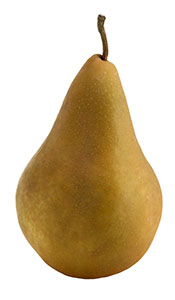
BOSC
This long, slim, russet-colored pear is the variety of choice for poaching, as it has a distinctive shape and firmer flesh that holds up to cooking. Sweet and musky, it can be enjoyed crisp or fully ripe—and its swan-like neck makes it the perfect choice for an elegant centerpiece.
Wine Pairings
Maryhill Winery 2014 Proprietor’s Reserve Cabernet Sauvignon, Columbia Valley, $40
Cab is king in Washington state, where orchards continue to be replaced by grape vines, and this reserve tier represents the best blocks Richard Batchelor works with. There’s beautiful varietal correctness with cassis lifting from the glass. Bing cherry, blackberry and earthiness entwine on the palate where firm tannins achieve precise balance. MaryhillWinery.com
Irvine & Roberts Family Vineyards 2015 Estate Chardonnay, Rogue Valley, $35
Robert Brittan’s magical touch with Burgundy varieties in the Willamette Valley shows up in his work for this young Southern Oregon project, extending to a Chardonnay that’s filled with finesse. A floral nose of citrus fruit, lavender and coriander leads to unctuous flavors of ripe peach, lemon cream and orange oil. IrvineRobertsVineyards.com
Quady North 2013 Mae’s Vineyard Syrah, Southern Oregon, $32
Take a trip to Châteauneuf-du-Pape via Rhône-inspired Herb Quady, a Southern Oregon winemaker with roots in Central California. Whole-berry fermentation with clusters from his young estate vineyard in the Applegate Valley create savory hints of charcuterie, earthiness and a classic sense of funk, backed by juicy flavors of Marionberry and black cherry. QuadyNorth.com
Cheese Pairings
Face Rock Creamery, Extra Aged Cheddar
Face Rock's Extra Aged Cheddar is a monger favorite at Zupan's with its buttery beginning and sharp balanced finish. The creamy mouthfeel with a crystalline crunch holds up nicely on a slice of Bosc pear with its firmer flesh. Put them both in a grilled cheese sandwich for a special treat!
Portland Creamery, Oregon Chevre + Cajeta
Farmstead chevre hailing from Molalla, Oregon, Portland Creamery's classic plain Oregon Chevre is a beautiful exhibition of high quality goat's milk and superior cheesemaking: clean, lemony flavors and an ultra-creamy, light, almost whipped-like texture. The light tanginess of the chevre is a perfect foil to their Cajeta, a goat's milk caramel made dulce de leche-style. The nutty, spicy flavor with undertones of vanilla, spice, and caramel of a slice of ripe Bosc pear provides the optimum vehicle for the chevre and a drizzle of Cajeta - the perfect bite.

BARTLETT
Sometimes called Williams, the Bartlett pear offers “quintessential pear flavor,” says Kathy, with a soft, juicy texture and aromatic flavor. Bartlett pears appear in stores in September, and last for a few months. Ripeness is essential for these pears; right off the tree, and it’s more like a potato than a pear.
Wine Pairings
Argyle Winery 2014 Vintage Brut, Willamette Valley, $28
Nate Klostermann sets the Northwest standard each year with his classic sparkling program of Pinot Noir, Chardonnay and Pinot Meunier. Fine and stylish bubbles toss up aromas of sweet lemon, white peach and pineapple with clove and ginger. A graceful mouth feel of Mandarin orange and Gala apple is capped by tangelo acidity. ArgyleWinery.com
Del Rio Vineyards 2016 Estate Grenache Rosé, Rogue Valley, $17
One of the West Coast’s most decorated rosés wears a lightly pink wardrobe that leads to a gorgeous nose of Ruby Red grapefruit, Rainier cherry and rose petal. Its bone-dry and ripe fruit approach comes across as strawberry-rhubarb compote and loganberry, backed by a nibble of cherry skin and a finish of lime peel. DelRioVineyards.com
Ponzi Vineyards 2016 Pinot Gris, Willamette Valley, $19
Second-generation winemaker Luisa Ponzi works with 40-year-old family plantings for her annually stellar and large-scale Pinot Gris program. Tropical aromas hinting at banana chips and jasmine include honeydew melon and yellow grapefruit. A slurp of white peach leads to deliciously tingly sensations of lime juice, orange zest and nectarine skin. PonziVineyards.com
Cheese Pairings
Mt. Townsend Creamery, Seastack
Named for the famous rock formations along Washington's coastline, Mt. Townsend Seastack from Port Townsend, WA is a creamy soft-ripened cow's milk cheese dusted with ash and sea salt. As it ripens from the outside-in, it softens and gains a luxuriously creamy consistency. The creamy texture, milky and earthy flavor profile, and salty finish pair nicely with a soft and sweet Bartlett pear.
Cascadia Creamery, Sleeping Beauty
Located at the base of Mt. Adams, Cascadia Creamery turns out beautifully unique organic and raw milk originals. Sleeping Beauty is a shining example - aged for up to 100 days in an on-site lava tube, it is smooth and buttery with a supple sharpness that is absolutely succulent with a ripe and sweet Bartlett pear.
RECIPES
Crostini of Arugula, Thick Cut Bacon, Red Anjou Pear, Mostarda & Goat Cheese
Galette of Pear, Blue Cheese & Piment d'Espalette




